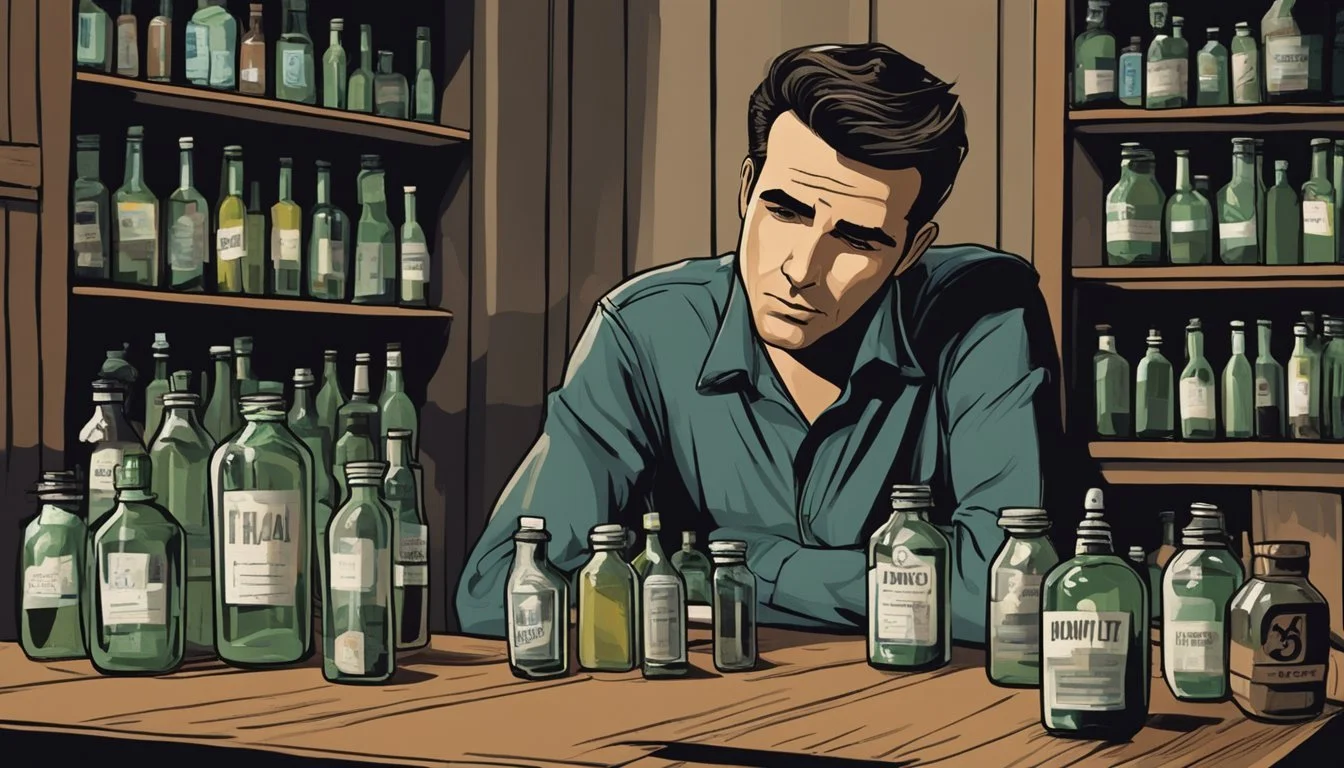Hollywood Heartthrob: Montgomery Clift's Tragic Struggle with Inner Demons
Montgomery Clift, a Hollywood icon of the 1950s, captivated audiences with his raw talent and brooding good looks. Born in Omaha, Nebraska, Clift made his way to New York's theater scene before becoming one of Tinseltown's most sought-after leading men. His performances in films like "A Place in the Sun" and "From Here to Eternity" earned him critical acclaim and solidified his status as a heartthrob.
Despite his on-screen success, Clift struggled privately with depression and substance abuse throughout his career. The pressures of fame and his efforts to conceal his sexuality in an era of rigid social norms took a toll on his mental health. A near-fatal car accident in 1956 left him with facial injuries, further exacerbating his inner turmoil.
Clift's battle with addiction and mental health issues cast a shadow over his later years in Hollywood. His once-promising career began to decline as he grappled with alcoholism and prescription drug dependency. Tragically, Clift's life was cut short at the age of 45, leaving behind a legacy of powerful performances and a cautionary tale of the hidden struggles faced by those in the spotlight.
Early Life and Rise to Fame
Montgomery Clift's journey from a small-town upbringing to Hollywood stardom was marked by early theatrical success and a meteoric rise in the film industry. His natural talent and striking good looks quickly set him apart as a leading man of his era.
Childhood in Omaha, Nebraska
Edward Montgomery Clift was born on October 17, 1920, in Omaha, Nebraska. He grew up alongside his twin sister Roberta and older brother Brooks. Clift's father, William Brooks Clift, was a successful banker, which afforded the family a comfortable lifestyle.
The Clifts moved frequently during Montgomery's early years. This nomadic childhood exposed him to diverse experiences and cultures, shaping his worldview and later influencing his acting career.
Transition to New York City
In his teens, Clift's family settled in New York City. This move proved pivotal for his budding acting career. He quickly immersed himself in the city's vibrant theater scene.
At just 13, Clift made his Broadway debut. He appeared in several acclaimed productions, including "There Shall Be No Night" and "Our Town." His performances on stage garnered attention and praise from critics and audiences alike.
Breakout Roles and Hollywood Success
Clift's transition to film came with his role in Howard Hawks' "Red River" (1948). The western showcased his brooding intensity and undeniable screen presence.
His subsequent performances in "The Heiress" (1949) opposite Olivia de Havilland and "A Place in the Sun" (1951) with Elizabeth Taylor cemented his status as a Hollywood heartthrob. These roles earned him critical acclaim and his first Academy Award nomination.
Clift's unique blend of vulnerability and masculinity set a new standard for leading men in Hollywood. His method acting approach and naturalistic style influenced a generation of performers.
Professional Triumphs
Montgomery Clift's career was marked by exceptional performances and innovative acting techniques. His talent and dedication to his craft earned him critical acclaim and respect from peers and audiences alike.
Critical Acclaim and Notable Performances
Clift's breakthrough role came in "The Search" (1948), which earned him his first Oscar nomination for Best Actor. He followed this with another stellar performance in "From Here to Eternity" (1953), securing a second nomination. His portrayal of a troubled soldier showcased his ability to convey complex emotions with subtlety and depth.
"Judgment at Nuremberg" (1961) further solidified Clift's reputation as a powerhouse actor. His brief yet impactful performance as a victim of Nazi experiments earned him a fourth Oscar nomination, this time for Best Supporting Actor.
In "Raintree County" (1957), Clift starred opposite Elizabeth Taylor, demonstrating his range and on-screen chemistry with one of Hollywood's most beloved actresses.
Collaborations With Renowned Actors
Clift's talent attracted collaborations with some of the industry's finest. He worked alongside Elizabeth Taylor in multiple films, including "A Place in the Sun" (1951), where their on-screen chemistry captivated audiences.
His partnership with Burt Lancaster in "From Here to Eternity" produced memorable scenes that have become iconic in film history.
Clift also caught the attention of legendary director Alfred Hitchcock, leading to his role in "I Confess" (1953). This collaboration showcased Clift's ability to thrive in suspenseful narratives.
Exploration of Method Acting
Clift was at the forefront of the Method Acting movement, along with contemporaries like Marlon Brando. He studied at the Actors Studio under Lee Strasberg, honing his craft and developing a naturalistic acting style.
His commitment to authenticity in performances set new standards in the industry. Clift's approach involved deep character immersion and emotional truth, often drawing from personal experiences to inform his portrayals.
This dedication to the craft influenced generations of actors who followed, cementing Clift's legacy as not just a talented performer, but also an innovator in acting techniques.
Personal Struggles
Montgomery Clift faced numerous personal challenges that profoundly impacted his life and career. His struggles with mental health, substance abuse, and sexuality shaped his experiences both on and off screen.
Battle With Depression and Alcohol
Clift battled severe depression throughout his adult life. The pressures of Hollywood fame and his own perfectionist tendencies exacerbated his mental health issues. To cope, he turned to alcohol, which quickly became a destructive force in his life.
His drinking habits interfered with work, causing him to miss filming days and behave erratically on set. The alcohol abuse also strained his relationships with colleagues and loved ones.
Substance Abuse and Health Decline
As Clift's substance abuse worsened, his health deteriorated rapidly. He developed chronic conditions like colitis and dysentery, likely exacerbated by his alcohol consumption.
Drug addiction further complicated his health issues. Clift became dependent on pain medications, leading to erratic behavior and unreliability in his professional life.
His physical appearance changed dramatically due to substance abuse, affecting his ability to secure leading roles. Clift's once-striking good looks faded, mirroring his internal struggles.
Impact of Sexuality on Private Life
Clift's sexuality was a source of personal conflict in an era of intense social stigma. Though he had relationships with both men and women, including actress Libby Holman and actor Tab Hunter, he kept his private life fiercely guarded.
The pressure to maintain a heterosexual public image in Hollywood took a toll on Clift's mental health. He lived in constant fear of exposure, which contributed to his anxiety and depression.
Clift's need for privacy regarding his sexuality limited his ability to form deep, lasting relationships. This isolation likely worsened his struggles with substance abuse and mental health.
Pivotal Life Incidents
Montgomery Clift's life was marked by two significant events that profoundly impacted his career and personal well-being. These incidents shaped public perception and altered the trajectory of his Hollywood journey.
Life-Changing Car Accident
In 1956, Clift was involved in a near-fatal car accident that left him with severe injuries. The crash occurred after leaving a dinner party at Elizabeth Taylor's home. Clift's face was badly disfigured, requiring extensive reconstructive surgery.
The accident dramatically altered his appearance, once lauded for its classic good looks. This physical transformation affected his ability to secure leading roles and impacted his self-esteem.
Despite the setback, Clift continued acting. However, his reliance on painkillers and alcohol to cope with ongoing pain intensified, exacerbating his existing substance abuse issues.
Power Dynamics and Hollywood Culture
Clift's experience in Hollywood exposed him to complex power dynamics that influenced his career and mental health. As a talented but troubled actor, he often found himself at odds with studio expectations.
His unconventional approach to stardom and reluctance to conform to typical Hollywood norms created tension. Clift's refusal to hide his sexuality in an era of strict moral codes put him at risk of blacklisting and limited his career options.
The pressure to maintain a certain public image while dealing with personal struggles took a toll on Clift's mental state. This conflict between authenticity and industry demands contributed to his depression and substance abuse.
Cultural Impact and Legacy
Montgomery Clift's influence on Hollywood and cinema extended far beyond his lifetime. His unique acting style and complex portrayals left an indelible mark on the industry and subsequent generations of performers.
Influence on Other Actors
Clift's naturalistic approach to acting inspired many of his contemporaries and future stars. James Dean and Marlon Brando, in particular, were heavily influenced by Clift's emotionally raw performances. His ability to convey vulnerability and inner turmoil on screen paved the way for a new breed of leading men in Hollywood.
Clift's style challenged the traditional macho image exemplified by actors like John Wayne. He showed that male characters could be sensitive and multifaceted, expanding the range of roles available to actors.
Posthumous Recognition
After his death, Clift's legacy continued to grow. The 2018 documentary "Making Montgomery Clift" reassessed his life and career, dispelling myths about his personal struggles.
Critics and film historians have lauded Clift's performances in classics like "From Here to Eternity" and "Judgment at Nuremberg". His four Academy Award nominations attest to the high regard in which he was held by his peers.
Clift's tragic decline, often referred to as "The Longest Suicide in Hollywood History", has become part of Hollywood lore. His story serves as a cautionary tale about the pressures of fame and the importance of mental health in the entertainment industry.
Selected Filmography
Montgomery Clift's career spanned both stage and screen, showcasing his remarkable talent and versatility as an actor. His filmography includes critically acclaimed performances in Hollywood classics, while his theatrical work laid the foundation for his success.
Notable Features and Collaborations
Clift's film career began with "The Search" (1948), earning him his first Oscar nomination. He starred in "Red River" (1948) alongside John Wayne, establishing himself as a leading man. "A Place in the Sun" (1951) with Elizabeth Taylor further cemented his status. "From Here to Eternity" (1953) garnered Clift another Academy Award nomination. He appeared in "Raintree County" (1957) and "The Misfits" (1961), his final completed film with Marilyn Monroe and Clark Gable. "The Defector" (1966) was released posthumously.
Stage Productions and Broadway Appearances
Before his film career, Clift gained recognition on Broadway. He debuted in "Dame Nature" (1935) at age 15. His performance in Thornton Wilder's "Our Town" (1938) caught critics' attention. Clift starred in "The Skin of Our Teeth" (1942), showcasing his range as a stage actor. He appeared in "Fly Away Home" (1935) and "The Wind and the Rain" (1934). These early theatrical experiences shaped his naturalistic acting style, which he later brought to Hollywood.
Remembering Montgomery Clift
Montgomery Clift's legacy continues through documentaries, biographies, and tributes that honor his talent and impact on cinema. These works shed light on his complex life and enduring influence.
Documentaries and Biographical Works
"Making Montgomery Clift" (2018) offers a fresh perspective on the actor's life, challenging long-held assumptions. Directed by his nephew Robert Clift and Hillary Demmon, the documentary uses personal recordings and family archives to reveal a more nuanced portrait.
Patricia Bosworth's 1978 biography "Montgomery Clift: A Biography" remains a comprehensive account of his life and career. The book delves into Clift's childhood, rise to stardom, and personal struggles.
"The Passion of Montgomery Clift" (2010) by Amy Lawrence examines his acting technique and screen presence. It analyzes his performances and their lasting impact on the craft of acting.
Tributes and Homages
The American Film Institute ranked Clift as the 23rd greatest male star of Classic Hollywood Cinema. This recognition cements his status as a cultural icon and influential actor of his era.
Film festivals occasionally feature Montgomery Clift retrospectives, showcasing his most memorable roles. These events introduce new generations to his work and highlight his contributions to cinema.
Contemporary actors often cite Clift as an inspiration. His naturalistic acting style and ability to convey complex emotions continue to influence performers today.
Art exhibitions have featured portraits and photographs of Clift, celebrating his striking looks and charismatic screen presence. These visual tributes keep his image alive in popular culture.





